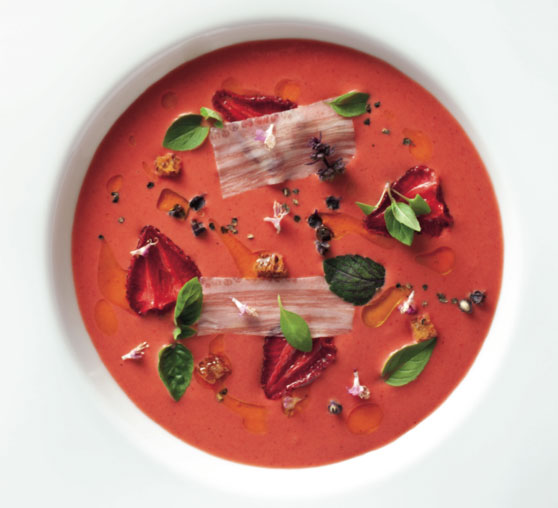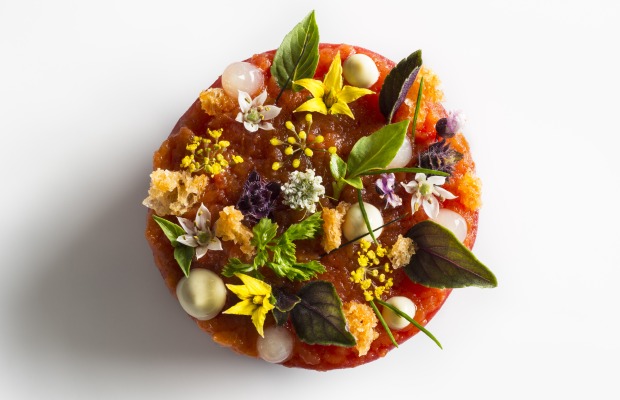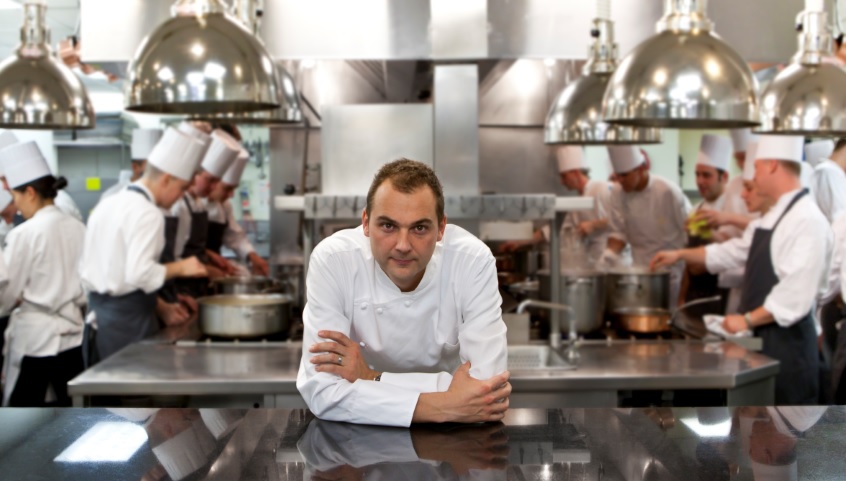Black and white cookies; chocolate-coated pretzels with sea salt; a mobile garden of sunflowers; a miniature picnic basket complete with ale and soda pop; a whole roast duck being ushered from table to table and a midget barbeque grill on your table – not quite what you would expect at Eleven Madison Park, wearing 3 Michelin-stars and currently ranked # 4 on the San Pellegrino list of 50 Best Restaurants in the World. Housed in the old Met Life building, with soaring windows that overlook Madison Square Park, at EMP, pristine, locally sourced ingredients form the basis of Daniel Humm’s menu, conceived on a grand scale and served in a classically elegant setting.
There are about 14 culinary movements on the menu, each one exquisitely orchestrated, whimsical, teasing, surprising and provocative. Each of them explores the nature of our taste memories in the most unexpected ways, diving deep into the flavours and freshness that define the simplest of café and bistro style cooking, the mélange of ingredients, nationalities and cooking traditions that threw up what are now iconic foods, and created a style of eating that is uniquely New York; then soaring to presentations in the best of French culinary traditions of fine dining, with touches of molecular gastronomy.
Tomato at EMP is a tea of intense flavours, with lemon thyme salad, strawberries and basil. Duck with raspberries, blueberries and mulberries, roasted on your table on a tiny barbecue grill, evokes memories of smoky summer meals with family and friends. New York City weaves its way in and out of the presentations, trailing history and multiple nationalities in its wake. Beef is pastrami with peppers, mustard, rye and strawberries, after an iconic New York sandwich. Chocolate covered pretzels evoke street-corner vendors, elevated by a sprinkling of gourmet sea salt; and the mini picnic baskets unpacked on the table remind us of summer, happening right now, outside those tall windows. A mobile garden of sunflowers accompanies the sunflowers braised with sunchokes and sunflower seeds, a vivid evocation of the season.

The service is impeccably coordinated, and I later learn that the Maître d’ googles the name of every guest who comes to dinner, to be able to offer the best personalized service possible. The young man who leads the team that attends to our table is lively, enthusiastic about everything at EMP and remains genuinely engaged to the end of what turns out to be a very extended meal.
What happens with Chef Daniel Humm’s inspired menus, executed with masterly precision and artistry is that, they make us aware of the depth and complexity of emotion in our responses to food and, in the process, they remind us of the perfection of simplicity. The belly of a city runs on legendary, often small establishments that may slip through a Zagat style net, but have fired the imaginations of generations of people, and continue to do so. Across the city are countless establishments, some of them over a century old that speak the same language as EMP, but in a way that may not be immediately recognizable. The kind of establishment where galley kitchens turn out stellar food, and the owner/manager knows every one of his regular guests, and returning visitors are quickly recognized. Service is usually superb, the longtime staff ingrained into the traditions of the establishment or, at worst eccentric, for the very same reason.
Pretzels and pastrami served on white linen prompt us to consider where our taste buds were first awakened –not in the hushed environs of a fine dining restaurant, but at a vendor’s cart at a street corner; with a perfectly made sandwich stuffed full of the best meat; fresh, locally sourced produce eaten outdoors or a meal of very few ingredients, cooked so well that you would like to return to a bistro or taverna to eat it again and again. The queues still snake out of Katz’s Delicatessen for the towering, stacked, iconic pastrami sandwich that has probably been around as long as Katz, since 1888. The family owned Veniero’s, which opened in 1894 still offers some of New York’s best desserts; regulars sit for hours over coffee and airy millefoligie stuffed with bavarian cream, while crowds mill around the front of the shop buying the famous pastries. Gelatos and artisanal ice creams flourish at Grom, on Bleeker Street, Greenwich Village, and in mid-town Manhattan, Il Tinello’s hasn’t thought to update it’s old-fashioned décor: the trolleys bearing antipasti still roll past, and the table-side theatricals of Dover sole being expertly de-boned, and Cesar salads being tossed up right before you continue to be part of the experience. Rustic Sicilian cooking flourishes at Ferdinando’s, Francesco Buffa’s tiny Brooklyn restaurant, where plaster saints and the Virgin Mary look down at diners enjoying aranicina –Sicilian rice balls stuffed with meat, ricotta and peas, and deep-fried, and platefuls of Linguini Marinara off well-worn, wooden tables. Francesco befriends every guest, and remembers one-time regulars, returning after a break of many years. A journey to Astoria is worth it for just the fresh grilled, smoky Greek octopus and a slab of galaktoboureko: baked phyllo pastry stuffed with semolina custard and soaked in syrup, at Stamatis, which serves family-style Greek food. And Ken’s Broome Street Bar, once haunted by artists and sculptors, currently in danger of shutting down, still produces unforgettable burgers wrapped in pita bread, which can be consumed unhurriedly. Café Luxembourg, on the Upper West Side is a classic bistro, stylish, unpretentious, where the Luxemburger, Steak Frites and Salmon Tartare draw neighbourhood diners, as well as celebrities every day of the week, the bistro valuable local asset, in much the same spirit as Ken’s. The popularity and longevity of many of these places makes the biggest statement about taste, and the way we love to eat.
The queues still snake out of Katz’s Delicatessen for the towering, stacked, iconic pastrami sandwich that has probably been around as long as Katz, since 1888. The family owned Veniero’s, which opened in 1894 still offers some of New York’s best desserts; regulars sit for hours over coffee and airy millefoligie stuffed with bavarian cream, while crowds mill around the front of the shop buying the famous pastries. Gelatos and artisanal ice creams flourish at Grom, on Bleeker Street, Greenwich Village, and in mid-town Manhattan, Il Tinello’s hasn’t thought to update it’s old-fashioned décor: the trolleys bearing antipasti still roll past, and the table-side theatricals of Dover sole being expertly de-boned, and Cesar salads being tossed up right before you continue to be part of the experience. Rustic Sicilian cooking flourishes at Ferdinando’s, Francesco Buffa’s tiny Brooklyn restaurant, where plaster saints and the Virgin Mary look down at diners enjoying aranicina –Sicilian rice balls stuffed with meat, ricotta and peas, and deep-fried, and platefuls of Linguini Marinara off well-worn, wooden tables. Francesco befriends every guest, and remembers one-time regulars, returning after a break of many years. A journey to Astoria is worth it for just the fresh grilled, smoky Greek octopus and a slab of galaktoboureko: baked phyllo pastry stuffed with semolina custard and soaked in syrup, at Stamatis, which serves family-style Greek food. And Ken’s Broome Street Bar, once haunted by artists and sculptors, currently in danger of shutting down, still produces unforgettable burgers wrapped in pita bread, which can be consumed unhurriedly. Café Luxembourg, on the Upper West Side is a classic bistro, stylish, unpretentious, where the Luxemburger, Steak Frites and Salmon Tartare draw neighbourhood diners, as well as celebrities every day of the week, the bistro valuable local asset, in much the same spirit as Ken’s. The popularity and longevity of many of these places makes the biggest statement about taste, and the way we love to eat.
In an interview, Daniel Humm remarked that he takes flavours and combinations that have been around for centuries and does something a little different. He also advises novices in the kitchen to begin with trying their hand at cooking a perfectly grilled ham and cheese sandwich Young chefs all seem to be pointing us in the direction where it all began. While the pursuit of fine dining and exquisitely plated food has reached a fever pitch across the globe, the search for the next new thing may well end in your neighbourhood delicatessen or family owned restaurant. The path to food nirvana may just lie closer than you imagined.
The Belly of a City was published in Food Lovers Magazine, Winter 2014.
Image Credits: Eleven Madison Park Restaurant




